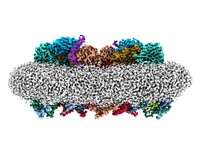Protein machinery of respiration becomes visible

Oxygen and sugar are the basis of life for animals, plants, fungi and many bacteria. The metabolic process called respiration makes it possible to convert food into energy for the cells. Biochemist Prof. Dr. Carola Hunte and her team from the Cluster of Excellence CIBSS at the University of Freiburg have now visualized for the first time with unparalleled precision how an assembly of protein machines, which also supplies energy to humans, is structured and functions.
The team studied two respiratory chain complexes fused into a supercomplex in a group of bacteria called Actinobacteria. In addition to providing a basic elucidation of respiratory processes, the cryogenic electron microscope analysis could aid in the development of new drugs to treat tuberculosis or diphtheria. "These images are like a journey into our molecular inner workings and its peculiar rules," Hunte explains, "Elucidating the structure simultaneously illuminates how the supercomplex works." The results of the study appeared in the journal Nature Communications and were produced in collaboration with Dr. Bruno Klaholz, research director at the Centre for Integrative Biology (CBI) / Institute of Genetics and of Molecular and Cellular Biology (IGBMC) of the CNRS, Inserm and the University of Strasbourg/France.
The energy currency of the cell
Adenosine triphosphate (ATP) is the energy currency of the cell—the molecule is obtained during respiration and transfers energy from food to all processes in the cell. Thanks to the processes on the respiratory chain, adenosine diphosphate is turned into the energy-rich ATP. To do this, protein complexes of the respiratory chain build up an electrochemical driving force across a membrane with electrons and protons in a complicated chemical-physical process that is powered by the combustion of sugar.
"We analyzed the respiratory cytochrome bcc-aa3 supercomplex. Twenty-six proteins make up the protein machine. The exact interaction of molecular forces and dynamics is not well understood yet, and this is where such a detailed description helps us," explains the study's first author Dr. Wei-Chun Kao of Hunte's team. The proton pump of the complex is very similar to humans, the researchers find, but the part where electrons are taken over by the electron carrier quinone shows clear differences in the bacterium. "This is where we could tie in and develop specific agents that kill pathogenic actinobacteria such as Mycobacterium tuberculosis or Corynebacterium diphtheriae by interfering with the respiratory chain," Hunte adds.
Cryogenic microscope with atomic resolution
Cryogenic electron microscopy (Cryo-EM) is a technique that examines samples at low temperatures of -183 Celsius in a high-resolution microscope and can resolve structures to the level of single atoms. In the process, machine learning algorithms are used to further refine the collected data. "With this data, we can also better understand the interplay of metabolism and signaling, which is a particular focus in the Cluster of Excellence CIBSS," Hunte emphasizes. She is a member of the CIBSS speaker team, which develops integrative approaches to biological signaling research. The cryo-EM measurements took place at the CBI/IGBMC in Strasbourg/Illkirch.
More information: Wei-Chun Kao et al, Structural basis for safe and efficient energy conversion in a respiratory supercomplex, Nature Communications (2022). DOI: 10.1038/s41467-022-28179-x
Journal information: Nature Communications
Provided by University of Freiburg



















